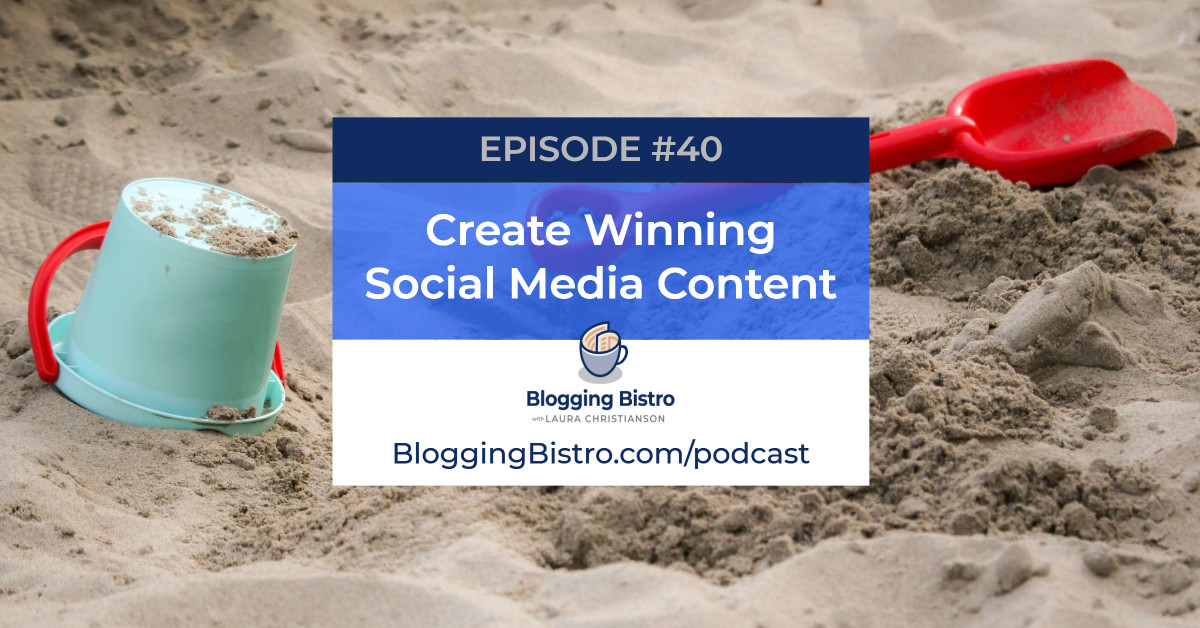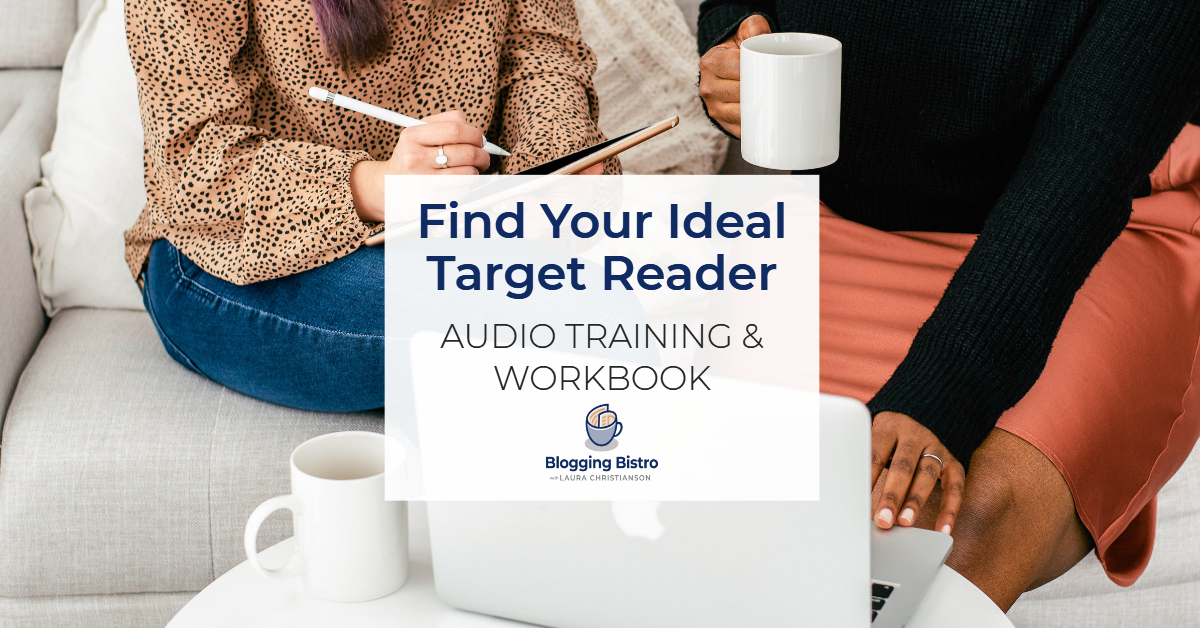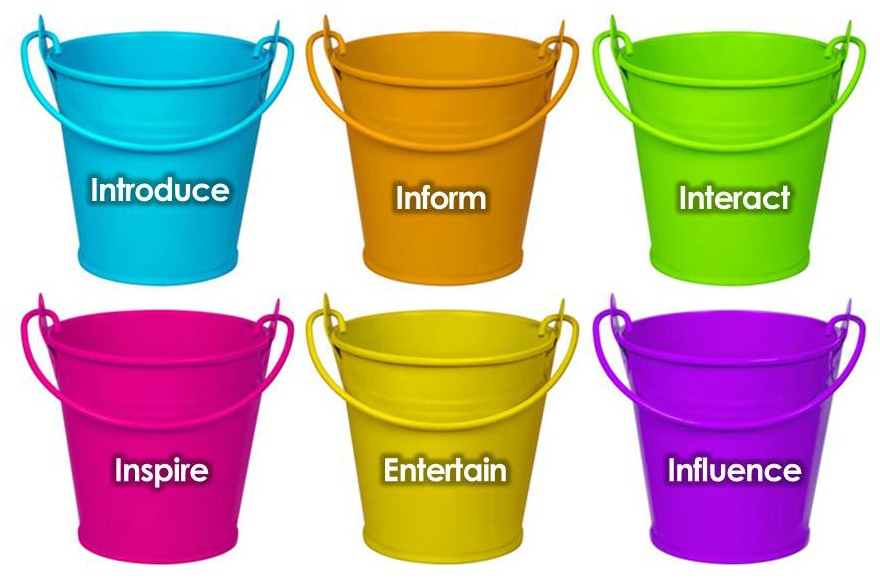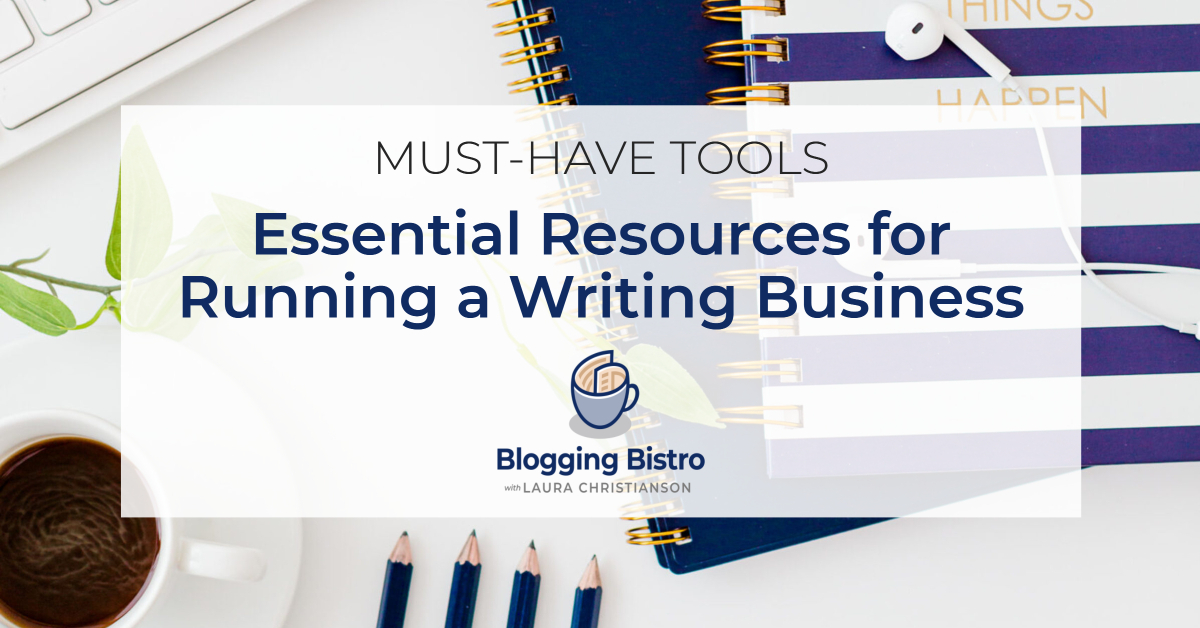40 – Create Winning Social Media Content

This is the second in a 4-part series on practical tips for effective social media marketing.
Last week, in part 1, “The Secret to Doing Social Media,” we began creating a master plan for managing our social media time.
Our focus was on becoming aware of how we use our time so we can stop doing things that don’t contribute to our business growth. We set a goal for how much time per day we will spend on social media, and where in our day we will do the bulk of our social media marketing.
Several listeners commented:
“All those things you said in the episode about not having (or making) time to do social media are true of me.”
They also commented that my massive action steps in Episode #39 are challenging. That’s true – unlearning bad habits and forming new habits that enable us to “do” social media productively and professionally is not easy to accomplish.
But putting these habits in place is foundational to presenting yourself as a professional writer. You can apply what you’re learning not only to social media, but to all the ways you market your writing-related business.
Before you dive into Part 2 and this week’s massive action steps, I want you to listen to or read Episode #39. Each of the episodes in this 4-part series builds on the previous one, so it’s important that you do the action steps in order.
Another episode I highly recommend listening to is Episode #12, Setting Big, Hairy, Audacious Goals. In Episode #12, I introduce you to a marketing mindset that’ll help you create a long-term plan that will consistently move your business forward.
- Today, in part 2, we’ll discuss how to create winning social media content.
- In part 3, we’ll talk about tools for scheduling our content.
- In part 4, we’ll discuss engaging with our audience, and how to monitor and adjust our master plan.
Let’s Talk Content.
I’m not talking about random cat or dog videos here – I’m talking about content we use to help us build our writing-related business.
Here’s how I view social media content: I consider every single thing I post on social media to be part of my writing portfolio.
That includes content I post to my personal profiles and my business accounts. People are watching how you present yourself professionally and personally on social media much more closely than you might imagine.
A lot of writers assume that what they post to their personal accounts doesn’t matter, so they ignore the rules of spelling, punctuation, and capitalization. Their posts look as if a 10-year-old wrote them, and they unwittingly lose credibility with their real-life friends, as well as with editors, agents, and prospective book buyers.
I realize that many social media posts are spur-of-the-moment and that we can’t expect the spelling and punctuation to be perfect, particularly when we’re typing on a touchscreen phone. But we can take an extra minute to proofread our posts and the comments we leave on others’ posts to clean them up before posting. Many social media platforms, such as Facebook, have an editing function where you can edit your post or a comment after publishing it. Take advantage of this feature!
Consider everything you post to social media as part of your writing portfolio.
If you were to compile all the social media content you’ve ever published and put it into a portfolio that you’d show to a literary agent as a sample of your writing, would you be proud to show them what you’ve published?
Before I acquaint you with a content-creation strategy, I want to back up a few steps to make sure you have some critical foundational pieces in place.
Identify Your Ideal Target Audience
First, WHO is your ideal target audience? This does not need to be one specific person, but rather, a community of people – of readers, clients, customers who are the BEST fit for the products, services, and programs you offer.
This is an area where many writers get it wrong, particularly when using social media. They assume their audience is other writers, and they amass thousands of Facebook friends, many of whom are other writers.
If you’re a book author, yes, other writers and authors might buy your book. But they probably won’t be your primary audience or your best audience.
If you suspect that you have some work to do in defining (or redefining) your ideal audience, be sure to sign up for my on-demand audio training called, “Find Your Ideal Target Audience.” During this 48-minute audio training, I’ll guide you through a series of questions that will help you discover and get to know your reader. The training includes a printable workbook.
Meet Your Audience’s Needs
After you have clearly defined the community of people you want to serve, focus on meeting their needs, as it relates to the core products, services, and programs you offer.
For a refresher on why it’s important to focus on helping your ideal audience overcome a challenge or working through a pain point, listen to Episode #14: Everyone’s Favorite Radio Station – Are You Tuned In?
Choose 1-to-3 Core Areas in Which You Want to Generate Revenue
Depending on how you structure your writing-related business, you are likely to have one or more revenue streams.
- Selling your books might be one revenue stream.
- Public speaking might be another revenue stream.
- Coaching and consulting is a third income stream many writers have.
- Editing is another popular income stream for writers.
My writing-related business has four core revenue streams:
- Consulting and coaching (with a focus on brand messaging, web-based writing, and email marketing)
- Custom WordPress website design and development (I share revenue with my team, which includes a graphic designer and a programmer.)
- Ghost writing (month-to-month content writing and management of the blogs and social media accounts of several clients)
- Speaking/teaching/training (includes the online workshops and courses I offer, plus teaching at writers conferences and online events)
Grab something to write with and quickly jot down the core area or areas in which you want to make money. If you’re not earning an income from your writing presently, write down areas in which you would like to earn money.
Maybe you’re not concerned about earning money – you may be volunteering your time for an organization or ministry, or writing for the sheer joy of it. But you still want to present yourself professionally and develop influence among your readers and followers. If that’s the case, write down the core area or areas in which you would like to develop influence and become recognized as an expert or specialist or go-to person in your niche.
Don’t overthink this – go with your gut.
What are you most passionate about doing – something you can easily envision yourself doing for the next three years and not getting tired of it or burned out? These areas should also mesh with the needs of your ideal audience.
In other words, if you’ve identified your ideal audience as a reader of Amish fiction and your novel is paranormal romance, you’re going to have a major disconnect between your audience, their desires, and what you offer.
In my case, my ideal audience describes themselves as a tech-challenged writer who wants some hand-holding as they learn to master the intricacies of blogging and email marketing. My coaching services are an excellent fit for that need.
As you plan the content that will go in your social media posts, your blog posts, your podcast episodes, the emails you send to subscribers, your speaking presentations, and your books, think about how the content you create will feed into your core revenue streams.
You never want to randomly post any old thing – that’s like throwing spaghetti at the wall and hoping it will stick. You’re being strategic and deliberate about the content you create and post, so that every iota relates directly or indirectly to one of your core areas and directs your audience towards your revenue-generating content.
I did that earlier in this episode, in fact. I started this episode by identifying the importance of knowing your ideal target audience. I included a call-to-action, inviting you to sign up for my low-cost audio training that will help you get to know your ideal target audience. That call-to-action fits directly into my core area of speaking/teaching/training, and indirectly into my core area of coaching and consulting. Often, people who go through the inexpensive on-demand audio training decide they would like to one-on-one coaching with me. And coaching is one of my premium, higher-priced services.
To recap, the goal of the content you create is to feed into the core revenue-generating areas in which you serve your ideal audience.
Content Buckets
I gently route my audience into my core revenue streams by organizing my content into six content buckets.
I use the term “content buckets” because it helps me visualize the types of content I want to create. I visualize 6 buckets – like those beach sand pails for kids that come with a little plastic shovel.
My 6 content buckets (or content categories):
- Introduce
- Inform
- Interact
- Inspire
- Entertain
- Influence
You can have as many or as few content buckets as you want, and you can name them whatever you want. The six I use cover the gamut of the types of content you’ll likely create.
As you listen to this next section of the episode, I recommend that you have a bunch of sticky notes by your side – even better if you have six colors of sticky notes. Or use a notebook or scribble pad or Word doc or whatever works best for you for brainstorming.
As we go through each of the six content buckets, jot down ideas that come to mind about specific content you could create for each bucket. We’re brainstorming here, so don’t worry about how weird or wacky your ideas are – just get them out of your head.
Content Bucket #1: Introduce
Key question to ask yourself:
“What does my ideal audience need to know about me in order to feel as if they know me, like me, and trust me?
We are most interested in buying from people, not from brands. So let your audience get to know the person behind the brand.
I am a private person, and my rule-of-thumb for sharing personal stuff online is:
What do I feel comfortable having the whole world know about me?
When you post anything online, you can never assume that it is private, even if your Instagram account is private or you share something in a secret Facebook group or only with your Facebook friends. You must assume that everything you post online may be viewed by anyone in the world.
Content that introduces you may include:
- Personal life – Be careful about sharing pictures of minors, such as your kids and grandkids. You don’t want to unintentionally set any child up as a potential target for a predator.
- Random thoughts – Try to achieve a balance. Remember that your goal is to grow your BUSINESS. While it’s fine to give people a glimpse into your sense of humor, don’t go overboard with off-brand posts.
- Deep thoughts – In episode #37, I talked about how thoughtless political posts can destroy your credibility. In the months leading up to the 2020 presidential election in the US, and in the weeks following the election, I watched countless people unwittingly destroy their professional credibility and lose hundreds of friends and followers by name-calling, insulting, shaming, and otherwise creating a divisive, negative atmosphere.
- Selfies – Use judiciously. I am friends with a couple of people on Facebook who constantly post selfies. If you own a hair salon and you’re showing customers 365 ways to style your hair, that makes sense. If you sell vintage shoes on Etsy and post selfies of your feet wearing a different pair of shoes each day, that makes sense. If you’re a celebrity and your millions of fans want to know what you’re doing every minute of your life, that makes sense. But if you’re a celebrity only in your own mind, those posed shots of you in front of the bathroom mirror get really old really fast. Your audience will wonder why you seem so in love with yourself.
- What you do all day – People enjoy seeing pictures of your work space, or of a new recipe you’re experimenting with or the people you work with. Change things up by posting a variety of videos (live and pre-recorded, pictures, text).
- Out and about – Events you attend, fun stuff you do.
Content Bucket #2: Inform
Key question to ask yourself:
“What does my ideal audience need to learn about my core areas?
Here’s where the 80/20 rule comes into play. The 80/20 rule specifies that 80% of the content you post should be educational content, where you help your audience solve a problem or meet a challenge. The other 20% of your content can be direct sales.
Word Nerd Moment
This principle of content creation directly mirrors the Pareto Principle, which was named after an Italian economist, Vilfredo Pareto. In 1906, Pareto noticed that 80% of the land in Italy was owned by only 20% of the population.
When describing the type of content you create for social media, the Pareto Principle rule of thumb is:
The majority of your results or outcomes or consequences come from the minority of your activities.
Your informational content might include:
- Instructional and how-to posts where you share your knowledge and expertise
- Your favorite tips/tools for accomplishing a specific goal or task
- Video, audio, and/or text-based tutorials
- Infographics
- Links to your blog posts, podcast episodes, vlogs, and guest posts on other people’s sites
- Links to or shares of someone else’s article that relates directly to one of your core services
Content Bucket #3: Interact
Key question to ask yourself:
“What does my ideal audience need to do within each of my core areas?
This is where you add an extra layer to the other five content buckets, by seeking to engage and interact with your followers and friends, based on the informational and inspirational content you’re consistently posting.
- Questions – Posts with questions get higher engagement than “statement” posts.
- Challenges – Share a challenge you’re facing, or challenge your readers to take an action based on something you’ve taught them.
- Polls, Surveys – Keep them short and simple, so your audience can instantly respond without having to think too much
- Quizzes – A fun way to help your audience determine where they stand, as it relates to your core services. Quizzes are a great opportunity for you to offer your products, programs, and services because the people who take the quiz are already interested in what you have to offer, and their responses help you dive into their minds and identify their key pain points.
- Facebook Live, Facebook Groups, Instagram Stories and Reels are all popular ways for you to interact with your audience.
Content Bucket #4: Inspire
Key question to ask yourself:
How do I want my ideal audience to feel when they encounter content in my core areas?
People buy with their emotions. Watch a few TV commercials or radio spots or print and online advertisements, and you’ll notice that the underlying sales pitch always plays on the emotions.
Why?
- We want to be right; we want to feel as if our choices are being validated.
- We want expert advice, particularly when we’re feeling overwhelmed with too many choices.
- We want to feel as if we’re special and unique, as if the person we’re following is putting our needs first.
- We want to prove ourselves; to stand out; to be viewed as not only capable, but exceptional.
When creating inspirational content, don’t try to manipulate the feelings of your audience only so you can sell them something. Focus on helping them achieve the transformation they long for. You can do this through:
- Inspirational or motivational graphics, videos, quotes, images
- Success stories – examples of how you’ve helped others
- Client testimonials
- Difficult situations you worked through
Content Bucket #5: Entertain
Sometimes, we need a break from all the serious stuff we’re confronted with every day, and we just want to laugh.
The “Entertain” content bucket is closely related to the “Inspire” content bucket because you’re eliciting emotions. In this case, your goal is to make your audience laugh, cry, or say, aaaah.
The most authentic type of entertaining content, in my opinion, is random stuff that happens during your day. Stay alert to what’s going on in your surroundings and post pithy reflections or snapshots about it.
When posting in the “Entertain” bucket, you can veer slightly off topic – your posts don’t need to relate directly to your core service areas. But be careful not to veer too far off topic, because that will create confusion among your audience about what your brand represents.
A lot of people post what I call “mindless memes” – pictures with text superimposed on them that are intended to be funny. And many of them are. Some of these folks see that they are getting a lot of likes and shares when they post memes, so they resort to posting only memes.
Remember the 80/20 rule: Change up your content regularly.
Content Bucket #6: Influence
This is promotional content that motivates your audience to buy. It might include:
- Pictures and samples of what you’re selling
- Giveaways or free downloads that include an upsell for one of your premium products, services, or programs
- Coupon codes and discounts
- Sell a service, product, or program
Be careful not to over-pitch but to follow the 80/20 rule:
No more than 20% of your content – or 2 out of 10 posts – should directly sell something.
Snackable Content
The average social media user’s attention span is 2.8 seconds. Focus on creating bite-sized, easily digestible content that stops the scroll and offers instant gratification.
Think of each social media post as a mini brand impression. Over time, all of your posts add up to create a “big picture” of your brand.
Experiment with a variety of mediums: video, visual, audio, text.
Mix it up:
- Create your own original content
- Curate other people’s content
Massive Action Steps
Decide which content buckets make the most sense for you to create content for – based on the core products, services, and programs you are creating that will bring about a positive transformation in the life of your ideal target audience.
Get a bunch of sticky notes in different colors and put a sticky note that represents each of your content buckets on a large sheet of paper (or bulletin board or white board).
On individual sticky notes, brainstorm topics and ideas for content that’ll go in each bucket and put them under the appropriate content bucket (with the understanding that most content you create can go in more than one bucket).
Get a large monthly calendar from an office supply store or print one at print-a-calendar.com.
Decide which content buckets you’ll feature on certain days of the week and begin plugging your sticky notes onto specific days of your calendar. This will ensure that you’re changing up your content weekly and are posting on a regular basis.
Every piece of content you post on social media is part of your writing portfolio.
Next week, in Part 3 of this series, we’ll talk about how to efficiently publish your social media content.
Resources Mentioned
Find Your Ideal Target Audience: During this 48-minute on-demand audio training, Laura will guide you through a series of questions that will help you discover and get to know your reader. Includes a printable workbook.
Episode #14: Everyone’s Favorite Radio Station – Are You Tuned In?
Episode #12: Setting Big, Hairy, Audacious Goals
Episode #37: How To Destroy Your Professional Credibility in One Easy Step
How to Keep Up With the Show
Click here to join my my email list and I’ll notify you about every episode. (When you subscribe, you’ll also get my free guide, Essential Resources for Running a Writing Business.)
Join The Professional Writer Podcast Community (private Facebook group), where we discuss what we’re learning, meet our guests, and encourage one another on our writing journeys.
If you know a writer who would be interested in The Professional Writer Podcast, please share this link with them:
https://bloggingbistro.com/podcast
Thank you!
Laura




